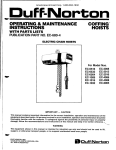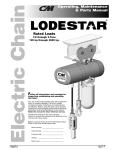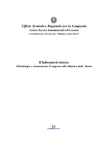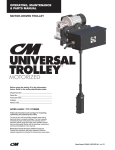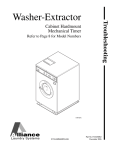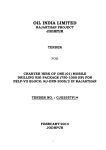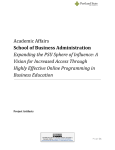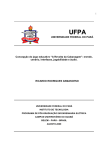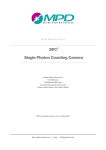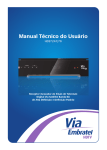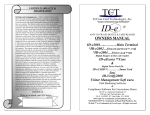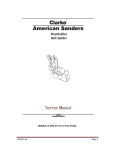Download Milwaukee 9573 Use and Care Manual
Transcript
OPERATOR’S MANUAL ELECTRIC CHAIN HOIST Catalog No. 9560 9561 9562 Rated Load 1/2 Ton 9565 9566 9567 9568 1 Ton 9570 9571 9572 9573 2 Ton The equipment described and illustrated in these instructions is intended for industrial use only and should not be used to lift, support or otherwise transport people. Follow all instructions and warnings for inspecting, maintaining and operating this hoist. The use of any hoist presents some risk of personal injury or property damage. That risk is greatly increased if proper instructions and warnings are not followed. Before using this hoist, each operator should become thoroughly familiar with all warnings, instructions, and recommendations in this manual. Retain this manual for future reference and use. Forward this manual to the hoist operator. Failure to operate the equipment as directed in the manual may cause injury. Before using the hoist, fill in the information below. Model and serial numbers are stamped into the aluminum hoist housing. Model Number Serial Number Purchase Date Milwaukee Electric Tool Corporation 13135 West Lisbon Road Brookfield, Wisconsin 53005 TEL: (800) 729-3878 20. NOT allow the load chain or hook to be touched by a live welding electrode. 21. NOT remove or obscure the warnings on the hoist. 22. NOT operate a hoist on which the safety placards or decals are missing or illegible. 23. NOT operate a hoist unless it has been securely attached to a suitable support. 24. NOT operate a hoist unless load slings or other approved single attachments are properly sized and seated in the hook saddle. 25. Take up slack carefully - make sure load is balanced and load holding action is secure before continuing. 26. Shut down a hoist that malfunctions or performs unusually and report such malfunction. 27. Make sure hoist limit switches function properly. 28. Warn personnel of an approaching load. SAFETY PRECAUTIONS Each MILWAUKEE Electric Chain Hoist is built in accordance with the specifications contained herein and at the time of manufacture complies with our interpretation of applicable sections of *American Society of Mechanical Engineers Code (ASME) B30.16 “Overhead Hoists,” the National Electrical Code (ANSI/NFPA 70) and the Occupational Safety and Health Act (OSHA). Since OSHA states the National Electrical Code applies to all electric hoists, installers are required to provide current overload protection and grounding on the branch circuit section in keeping with the code. Check each installation for compliance with the application, operation and maintenance sections of these articles. *Copies of this standard can be obtained from ASME Order Department, 22 Law Drive, Box 2300, Fairfield, NJ 07007-2300, U.S.A. Improper operation of a hoist can create a potentially hazardous situation which, if not avoided, could result in minor or moderate injury. To avoid such a potentially hazardous situation, THE OPERATOR SHALL: Improper operation of a hoist can create a potentially hazardous situation which, if not avoided, could result in death or serious injury. To avoid such a potentially hazardous situation, THE OPERATOR SHALL: 1. Maintain firm footing or be otherwise secured when operating the hoist. 2. Check brake function by tensioning the hoist prior to each lift operation. 3. Use hook latches. Latches are to retain slings, chains, etc. under slack conditions only. 4. Make sure the hook latches are closed and not supporting any parts of the load. 5. Make sure the load is free to move and will clear all obstructions. 6. Avoid swinging the load or hook. 7. Make sure hook travel is in the same direction as shown on the controls. 8. Inspect the hoist regularly, replace damaged or worn parts, and keep appropriate records of maintenance. 9. Use MILWAUKEE recommended parts when repairing the unit. 10. Lubricate load chain per hoist manufacturer’s recommendations. 11. NOT use the hoist’s overload limiting clutch to measure load. 12. NOT use limit switches as routine operating stops. They are emergency devices only. 13. NOT allow your attention to be diverted from operating the hoist. 14. NOT allow the hoist to be subjected to sharp contact with other hoists, structures, or objects through misuse. 15. NOT adjust or repair the hoist unless qualified to perform such adjustments or repairs. 1. NOT operate a damaged, malfunctioning or unusually performing hoist. 2. NOT operate the hoist until you have thoroughly read and understood the manufacturer’s Operating and Maintenance Instructions or Manuals. 3. NOT operate a hoist which has been modified without the manufacturer’s approval or without certification that it is in conformity with ANSI/ASME B30 volumes. 4. NOT lift more than rated load for the hoist. 5. NOT use hoist with twisted, kinked, damaged, or worn load chain. 6. NOT use the hoist to lift, support, or transport people. 7. NOT lift loads over people. 8. NOT operate a hoist unless all persons are and remain clear of the supported load. 9. NOT operate unless load is centered under hoist. 10. NOT attempt to lengthen the load chain or repair damaged load chain. 11. Protect the hoist’s load chain from weld splatter or other damaging contaminants. 12. NOT operate hoist when it is restricted from forming a straight line from hook to hook in the direction of loading. 13. NOT use load chain as a sling, or wrap chain around load. 14. NOT apply the load to the tip of the hook or to the hook latch. 15. NOT apply load unless load chain is properly seated in the chain sprocket(s). 16. NOT apply load if bearing prevents equal loading on all load supporting chains. 17. NOT operate beyond the limits of the load chain travel. 18. NOT leave load supported by the hoist unattended unless specific precautions have been taken. 19. NOT allow the load chain or hook to be used as an electrical or welding ground. 2 Milwaukee Electric Tool Corporation 13135 West Lisbon Road Brookfield, Wisconsin 53005 TEL: (800) 729-3878 TABLE OF CONTENTS Safety Precautions ......................................................................................................................................................................2 Hoist Specifications.....................................................................................................................................................................3 Application Information ...............................................................................................................................................................4 Safety Information .......................................................................................................................................................................4 Installation ...................................................................................................................................................................................4 Operation ....................................................................................................................................................................................5 Maintenance ...............................................................................................................................................................................6 Wiring Diagrams .......................................................................................................................................................................12 Trouble Shooting .......................................................................................................................................................................13 Inspection and Maintenance Check List ...................................................................................................................................14 Recommended Lubrication Schedule.......................................................................................................................................15 Replacement Parts List.............................................................................................................................................................16 Parts Depot & Warranty Repair Centers...................................................................................................................................28 Warranty .....................................................................................................................................................................Back Cover HOIST SPECIFICATIONS MILWAUKEE Electric Chain Hoists are rugged, portable hoists that provide quick, precise lifting. The hoists are constructed of tough, but lightweight, die cast aluminum alloy housings. An oil bath transmission, equipped with heat-treated, alloy steel gears and an overload limiting clutch, provides smooth and reliable operation. Other features that ensure the safe operation of MILWAUKEE Electric Chain Hoists include a magnetic disc brake that delivers sure stopping and secure holding of the load. Adjustable upper and lower limit switches regulate the load travel. As a standard, hooks are supplied with safety latches. For additional safety, a chain stop is attached to the slack end of the load chain. With a pushbutton station that fits comfortably in one hand, the operator can safely control the hoist while the other hand is free to guide the load. The electrical controls, which are readily accessed under the electrical cover, utilize quick connections for easy voltage conversions and a 24V control circuit for added safety. MILWAUKEE Electric Chain Hoists are designed and tested in accordance with the American Society of Mechanical Engineers Code B30.16, “Safety Standard for Overhead Hoists.” Hoists are built in compliance with CSA, file number LR 44484. Made in U.S.A. Table 1 - Hoist Specifications Model Capacity (tons) Lifting Speed (fpm) Lift (ft) 9560 1/2 16 10 9561 1/2 16 15 9562 1/2 16 20 9565 1 16 9567 1 16 9568 1 9566 Control Cord Length (ft) Full Load Motor Amps * Phase 115/230V 7.6/3.8 Single 115/230V 7.6/3.8 Single 1/2 115/230V 7.6/3.8 Single Single-chained 1 115/230V 14/7** Single Single-chained 1 115/230V 14/7** Single 16 Single-chained 1 115/230V 14/7** Single 6 Single-chained 1 230/460V 3.2/1.6 Three 10 6 Double-chained 1 115/230V 14/7** Single 15 11 Double-chained 1 115/230V 14/7** Single 8 20 16 Double-chained 1 115/230V 14/7** Single 8 10 6 Double-chained 1 230/460V 3.2/1.6 Three Reeving HP Voltage (AC) 6 Single-chained 1/2 11 Single-chained 1/2 16 Single-chained 10 6 15 11 16 20 1 16 10 9570 2 8 9572 2 8 9573 2 9571 2 * At full load, it is not unusual for the hoist to draw in excess of the values listed when lifting. It is critical to ensure that the voltage at the hoist contactor does not drop below 10% of the nominal voltage of the hoist while it is lifting a load. Low voltage will result in higher amp draw, damage to the hoist, and potential fire hazards. MILWAUKEE is not responsible for any damages caused by an inadequate power source. **The 1HP, 115/230V models must have a dedicated power circuit rated for at least 20A, 125V when they are wired for 115V. It is not unusual for these models to draw up to 20 amps at 115V when lifting at rated capacity. Refer to Table 3 before installation. 3 Milwaukee Electric Tool Corporation 13135 West Lisbon Road Brookfield, Wisconsin 53005 TEL: (800) 729-3878 APPLICATION INFORMATION Always disconnect the power source before working on or near a hoist or its connected load. If the power disconnect point is out of sight, lock it in the open position and tag to prevent unexpected application of power. This hoist is intended for general industrial use for lifting and transporting freely suspended material loads within its rated capacity. MILWAUKEE cannot be responsible for applications other than those for which MILWAUKEE equipment is recommended. Prior to installation and operation, we caution the user to review his application for abnormal environmental or handling conditions and to observe the applicable recommendations as follows: 4. Protect the power cable and control cable from coming in contact with sharp objects. 5. Do not kink power cable and control cable and never allow the cable to come in contact with oil, grease, hot surfaces, or chemicals. 6. Make certain that the power source conforms to the requirements of your equipment. 7. Inspect the unit daily before operating hoist. 8. Cluttered areas and benches invite accidents. 9. The operator should not engage in any practice which will divert his attention while operating the hoist. 10. Before using the hoist, the operator should be certain that all personnel are clear. 11. Do not operate hoist with loads exceeding its rated capacity. 12. Supporting frames or beams used as a hoist hanger must have a greater load capacity than the hoist. 13. Do not attempt to operate hoist beyond normal maximum lift range. 14. Align hoist for a straight line pull. Avoid side pull or end pull. 15. Do not operate hoist with twisted or damaged chain. 16. Do not operate a damaged or malfunctioning hoist until necessary adjustments or repairs have been made. 17. Do not use hoist to lift people or to carry loads over people. 18. Do not leave a load suspended in the air unattended. 19. Always remove load before making repairs. 20. Do not remove or obscure capacity or warning decals. ADVERSE ENVIRONMENTAL CONDITIONS Do not use the hoist in areas containing flammable vapors, liquids, gases or any combustible dusts or fibers. Refer to Article 500 of the National Electrical Code. Do not use this hoist in highly corrosive, abrasive or wet environments. Do not use this hoist in applications involving extended exposure to ambient temperatures below -10°F or above 130°F. LIFTING OF HAZARDOUS LOADS This hoist is not recommended for use in lifting or transporting hazardous loads or materials which could cause widespread damage if dropped. The lifting of loads which could explode or create chemical or radioactive contamination if dropped requires fail-safe redundant supporting devices which are not incorporated into this hoist. LIFTING OF GUIDED LOADS This hoist is not recommended for use in the lifting of guided loads, including dumbwaiters and elevators. Such applications require additional protective devices which are not incorporated into this hoist. For such applications, refer to the requirements of applicable state and local codes, and the American National Safety Code for elevators, dumbwaiters, escalators and moving walks (ASME A17.1). INSTALLATION 1. Before installing the hoist, check the following: a. Make sure all supporting structures and attaching devices are strong enough to hold your intended loads. If in doubt, consult a qualified structural engineer. b. Provide proper branch circuit protection for the hoist as recommended in the National Electrical Code. c. The power supply should be within plus or minus 10% of the voltage specified on the motor nameplate. It is critical to use adequate sized power cables, especially with 1-phase hoists (See Table 3). Be sure dual voltage hoists are connected or wired to correspond with your power supply (See WIRING, page 9). d. Installation area must provide operating conditions for the operator including sufficient room for the operator and other personnel to stand clear of the load at all times. e. For installations where the slack chain hanging from the unit may be objectionable or hazardous, the use of a chain container is recommended. See INSTALLATION OF CHAIN CONTAINER ASSEMBLY. Failure to comply with Safety Precautions outlined throughout this manual can result in serious injuries or death. Before using this hoist, each operator should become thoroughly familiar with all warnings, instructions and recommendations in this manual. SAFETY INFORMATION 1. Follow all local electrical and safety codes, as well as the National Electrical Code (NEC) and the Occupational Safety and Health Act (OSHA) in the United States. 2. Hoist must be securely and adequately grounded. The hoist power cable is provided with an additional lead (green) for grounding purposes. 3. Be careful when touching the exterior of an operating motor; it may be hot enough to be painful or cause injury. With modern motors this condition is normal if operated at rated load and voltage (modern motors are built to operate at higher temperatures). 4 Milwaukee Electric Tool Corporation 13135 West Lisbon Road Brookfield, Wisconsin 53005 TEL: (800) 729-3878 2. Before operating the hoist, be sure to observe the following: a. ALWAYS DISCONNECT HOIST FROM POWER SUPPLY before removing the electrical cover or when making any electrical connection in the hoist or pushbutton station. b. The ground wire (green colored) of the power cable should always be connected to a suitable ground by means of a screw or clamp. An alligator clip does not make a safe ground connection. c. When installing a three-phase hoist, make only temporary connections at the power source. Push the “UP” button and observe the direction of the load block. If it raises, the phasing is correct and permanent connections may be made at the power source. If the load block lowers when the “UP” button is pushed, release the button immediately since the limit switches will not operate to protect the hoist from over-travel. Reverse any two wires (except the green ground wire) at the power source to correct the load hook direction (phasing). Do not change connections in the hoist or pushbutton assembly. d. Make sure load chain is not twisted as it travels into the hoist. e. Operate hoist in a hanging position only. Hoist should be permitted to align itself for a straight line pull. Do not attempt to pull around corners. f. Read ASME-B30.16 Safety Code for Hoists. 3. If necessary, lubricate the chain, see LUBRICATION, page 9. 4. Check the function of the limit switches. Before placing hoist in operation, check limit switch adjustment. Operate pushbutton until near stop point and inch into stop limit both top and bottom. If either switch is not correct, adjust according to LIMIT SWITCH ADJUSTMENT, page 8. Retainer Clip Attachment Pin Figure 1 — Installing Chain Container Assembly 4. Feed the remainder of chain into container by operating hoist in the “UP” direction to the top limit. This will permit the chain to pile freely and prevent the chain from kinking, which may occur if the chain is placed in the container by hand. OPERATION This hoist is designed for safe operation within the limits of its rated capacity. It is controlled with the “UP” and “DOWN” buttons of the pushbutton station. There are many safety features to protect the operator from injury due to failure of the hoist. Here are some points which should be observed to maintain safe operation. 1. Do not overload the hoist. 2. Do not make extreme side pulls with the hoist. 3. Operate the hoist only in a hanging position with adequate support. 4. Do not “sling” the load hook and chain around the load. Use an approved sling. 5. Be sure there are no twists in the load chain as it travels into the hoist housing. This condition should be constantly checked on double chain hoists because it is possible for the load block to be “capsized” or turned over one or more times. 6. Before raising a load, always check to see that it is held securely in the hook or sling chains, etc. Raise the load only until the load chain is taut and then double check the rigging before continuing to raise the load. 7. Do not stand beneath a load! Do not move a load in such a manner as to endanger personnel. 8. Do not lower into areas where visibility is obscured unless someone else is guiding the operation. 9. Use common sense at all times when operating a hoist. 10. Do not operate if direction of hook travel is not the same as indicated on button being pushed. 11. Do not operate unless hook travel limit devices function. Test without load each shift. Installation of Standard Chain Containers Refer to Figure 1. 1. Remove retaining clip and attachment pin and let the slack chain hang free. 2. Run load hook down to its lowest position. Place the slack end of chain in chain container. Do not remove the chain stop. 3. Place chain container flush against housing with chain stripper between top lugs. Insert long attachment pin and replace retaining clip. Do not allow load to come in contact with the chain container. If this situation exists reset the “UP” limit switch so that the hook block stops below the chain container (See LIMIT SWITCH ADJUSTMENT, page 8). Table 2 - Optional Chain Container Standard Lifts (ft) Chain Container Required Shipping Weight (lbs) Width 10, 15, & 20 48-12-0116 3 3 6½ 11½ 2 Ton 10 48-12-0116 3 3 6½ 11½ 2 Ton 15 48-12-0117 4 3 6½ 18½ 2 Ton 20 48-12-0118 5 6 6½ 27 Hoist Capacity 1/2 & 1 Ton 5 Dimensions in Inches Length Depth Milwaukee Electric Tool Corporation 13135 West Lisbon Road Brookfield, Wisconsin 53005 TEL: (800) 729-3878 LOWERING WITHOUT POWER If the power fails with a load suspended, the hoist will automatically stop. In an emergency the load can be lowered without power as follows: Do not use hoist to lift, support or otherwise transport people. 12. Do not operate when hoist is not centered over load. 13. Do not operate if chain is not seated properly in sprockets or sheave grooves. 14. Do not operate damaged or malfunctioning hoist. 1. DISCONNECT HOIST FROM POWER SUPPLY AND REMOVE ELECTRICAL COVER. 2. Open disc brake manually by using two screwdriver blades, one on each side of the brake at a point close to the brake spring posts. Apply pressure to the underside of the armature plate (points “X”, Figure 5, page 9) to close the solenoid and release the brake. OVERLOAD LIMITING PROTECTION This hoist is equipped with a factory-calibrated overload limiting clutch that will permit the lifting of loads within its rated capacity, but will prevent the lifting of damaging overloads while the hoist is being operated. If the load being lifted exceeds the lifting capability of the overload clutch, the hoist motor will continue to run, causing overheating of both the clutch and hoist motor. This condition should be avoided by immediately releasing the “UP” button and reducing the load to within the rated capacity of the hoist. See GEARING, page 10, for additional instructions on this device. Do not allow screw driver blades to touch rotating friction disc “C”. Do not allow the load to descend rapidly. This causes the motor to race and serious damage may result. 3. Use several quick releases instead of holding brake open continuously. Do not exceed normal lowering speed. The overload limiting clutch is an emergency protective device and should not be used to measure the maximum load to be lifted, or to sense the overload imposed by a constrained load. While the overload limiting clutch will protect the hoist from damaging overloads, it will not ensure that a load is within the rated capacity of the hoist. HOOKS Refer to Figure 2. 1. Inspect hooks once daily for cracking, extreme wear or spreading. Replace hooks showing any of these signs. If the throat openings are spread wider than the maximum permissible 15% increase listed here, the hooks have been overstressed and must be replaced. Any hook that is bent or twisted more than 10° from the plane of an unbent hook must also be replaced. 2. The hook latches should be inspected to ensure that they close the hook throat opening in a secure manner when a load is applied. Inspect the hook shank and nut for any stripping of the threads or other damage. The hook nut should be fully restrained by the retaining pin. 3. In addition to above, load hooks should be inspected for cracks by the magnetic particle, dye penetrant or other suitable crack testing inspection method. This should be done at least once a year. MAINTENANCE INSPECTIONS A planned inspection routine should be established for this hoist based upon frequency of use, severity of use, and environmental conditions, (Reference ASME Standard B30.16). Some inspections should be made frequently (daily to monthly) and others periodically (monthly to yearly). It is strongly recommended that an Inspection and Maintenance Check List and an Inspector’s Report, similar to those shown in Figures 10A and 10B, be used and filed for reference. All inspections should be performed or overseen by a designated inspector. Special inspections should be made following any significant repairs or any operating occurrence leading one to Figure 2 — Hook suspect that the hoist’s capability may have been impaired. Inspection X “X” Dimension* Hoist Capacity 1 Ton & Under 2 Ton Top Hook Bottom Hook 111/32" 111/32" 17/32" 111/32" (*) Maximum permissible throat opening of hook. 6 Milwaukee Electric Tool Corporation 13135 West Lisbon Road Brookfield, Wisconsin 53005 TEL: (800) 729-3878 6. Using the “C” link, attach the new chain to the load end of the old chain. Be sure that the welds of the upstanding links of the new chain will face outward from the load sheave. The end links must be oriented for attachment to the deadend screw and the chain support (double-chained only) without any twist in the chain. CHAIN Chain is to be kept clean and lubricated (See LUBRICATION, page 9). Visually check chain every time hoist is used. Hoist must not be operated when chain is twisted or kinked. An important phase of hoist maintenance is chain inspection. Check individual links and check for chain elongation. 1. Check the chain for overall wear or stretch by selecting an unworn, unstretched length of chain (at the slack end for example). Let the chain hang vertically with a light load (about 20 pounds) on the chain to pull it taut. Use a large caliper to measure the outside length of a convenient number of links (about 12"). Measure the same number of links in a used section of chain and calculate the percentage increase in length of the worn chain. 2. If the length of the worn chain is more than 1½% longer than the unused chain (0.015" per inch of chain measured), then the chain should be replaced. If the chain is worn less than 1½%, check it at several more places along its length. If any section is worn more than 1½%, the chain should be replaced. Double-Chain Only Figure 4 — Chain Replacement Diagram 7. With the electrical cover off, connect the hoist to the power supply. Be sure that the green ground wire is properly grounded (See INSTALLATION, page 4). 8. Carefully jog the “UP” button and run the joined pieces of chain into the hoist until about 15" of the new chain comes out the other side. 9. DISCONNECT HOIST FROM POWER SUPPLY. 10. Remove the “C” link and the old chain. Remove the chain stop from the old chain by prying off its retaining ring with a flathead screwdriver. If attached, remove the old chain from the side of the hoist by removing the dead-end screw and washers (note placement of washers). 11. Attach the chain stop to the slack end of the new chain by capturing the 12th link with the two stop halves positioned with their tapered ends pointing towards the hoist. Slide the sleeve over the halves and attach the retaining ring. If you are not using a chain container, attach the slack end of the new chain to the side of the hoist using the dead-end screw and washers. With factory supplied hardware there should be six washers between the hoist and chain link and two washers between the chain link and screw head. DO NOT allow twists in the chain. 12. Adjust the lower limit switch (See ADJUSTING LOWER LIMIT, page 8). 13. Attach the bottom block on single-chained hoists using a new load block screw (See Figure 20). On double-chained hoists, feed the chain through the load block (welds of the upstanding links will be in towards the sheave) and fasten the end of the chain to the chain support using a new chain support pin (See Figure 20). Be sure there are no twists in the chain. 14. Adjust the upper limit switch (See ADJUSTING UPPER LIMIT, page 8). The chain used on this hoist has very carefully controlled dimensions and has been heat treated. Do not attempt to substitute other manufacturer’s chain. Silver Nut (Down) Gold Nut (Up) Spring Guide Plate Figure 3 — Limit Switch Assembly Chain Replacement with Chain in Hoist Refer to Figures 3 & 4. 1. Run hook up to its top limit. 2. DISCONNECT HOIST FROM POWER SUPPLY and remove the electrical cover. 3. Using a screwdriver, pry the spring guide plate out of the slots in the limit switch nuts (See Figure 3). Turn the slotted nut nearest you, the gold nut, back to about the center of the threaded screw. Do not disconnect the wires from the limit switches. 4. Remove the load block assembly from the old chain. On double-chained hoists detach the chain from the chain support and pull it through the load block assembly (See Figure 4). 5. Make a “C” shaped chain link by grinding through the end link on the load end of the old chain. 7 Milwaukee Electric Tool Corporation 13135 West Lisbon Road Brookfield, Wisconsin 53005 TEL: (800) 729-3878 2. DISCONNECT HOIST FROM POWER SUPPLY and remove the electrical cover. 3. With a screwdriver, pry the spring guide plate out of the slots in the limit switch nuts. 4. Turn the slotted gold nut toward its limit switch until the switch “clicks” then turn two slots farther. Release the spring guide plate and be sure it slips back into the slots in both limit switch nuts. Do not disturb the silver slotted nut if it has been set previously. Adjusting Lower Limit (Silver Nut) Refer to Figure 3. Chain Replacement with No Chain in Hoist Refer to Figures 4 and 5. 1. DISCONNECT HOIST FROM POWER SUPPLY and move hoist to a work table. Remove the electrical cover, electrical panel and the electric brake assembly. 2. Detach the chain stripper from the bottom of the hoist. 3. Insert the new chain between the load sheave and the chain guide. Feed the chain into the hoist by manually turning the brake hub. Allow about 15" of chain below the hoist on the slack end. Be sure the welds of the upstanding links are out away from the load sheave and that proper orientation is observed for attachment of the slack end. Also be sure the load hook assembly (if already attached to the chain) is toward the center of the hoist or to your right looking from the transmission end. 1. Suspend the hoist. Carefully lower the load block to a point where the slack-end loop of the chain hangs down 6" or more from the hoist housing (or the limit desired in any particular application allowing the minimum 6"). There should be a minimum clearance of 1½" between the chain stop and the bottom of the hoist. 2. DISCONNECT HOIST FROM POWER SUPPLY and remove the electrical cover. 3. With a screwdriver, pry the spring guide plate out of the slots in the limit switch nuts. 4. Turn the slotted silver nut toward its limit switch until the switch “clicks,” then turn two slots farther. Release the spring guide plate and be sure it slips back in the slots in both limit switch nuts. Do not disturb the gold slotted nut if it has been set previously. Check Both Upper and Lower Limits 1. Connect the hoist to the power supply. Be sure the green ground wire is properly grounded . 2. Check load hook direction (See INSTALLATION 2-c, page 5). 3. Carefully raise load block to upper limit and observe if it stops automatically at desired level. Do not allow load block to run into hoist housing — this will damage the hoist. Maintain a minimum clearance of 2" from the hoist housing and the top of the load block on single-chained models and 1" from the chain support to the top of the load block on double-chained models. 4. Carefully lower load block to lower limit and observe if it stops automatically at the desired level. Do not allow slackend loop of chain to become taut against hoist housing. This will damage the hoist. There should be a minimum clearance of 1½" between the chain stop and the bottom of the hoist. 5. If upper and lower limits operate satisfactorily, hoist is ready for use. If they are not as desired, repeat adjustment. There are wires running through the hoist. Carefully ease the hoist sections apart. Do not jerk them apart. 4. Reinstall the chain stripper (with the chain anchor on doublechained hoists, See Figure 4) observing proper chain alignment and avoiding any twist in the chain. 5. Follow steps 11 through 14 in previous section, CHAIN REPLACEMENT WITH CHAIN IN HOIST, to complete the chain replacement procedure. NOTE: Inspect chain guides and load sheave for wear, replace as needed. LIMIT SWITCH ADJUSTMENT IMPORTANT: Before placing hoist in operation, check the limit switch adjustment. Limit switches are provided to protect the hoist against damage resulting from overtravel or to allow setting the hook travel within the factory-set limits of travel. For easy identification and association with the proper direction of travel, the upper and lower limit switch adjusting nuts are colorcoded gold and silver respectively. Each limit nut has 10 slots for fine adjustment, and the increment of adjustment is such that one slot is equivalent to approximately one link of chain travel. Movement of the limit switch nuts toward or away from each other increases or decreases the hook travel respectively. Care should be exercised when adjusting either limit of travel. BRAKE If the wires running to the limit switches are ever disconnected for any purpose, be sure to replace wires in accordance with the correct wiring diagram (See WIRING DIAGRAMS, page 12). Properly adjusted, this brake will release promptly when energized. It is capable of both smoothly stopping and securely holding the rated capacity of the hoist. If the hoist develops either undesirable over-travel after the pushbutton is released (this condition is most noticeable in the lowering direction) or hesitates to lift the load promptly when the pushbutton is depressed (this condition is most noticeable in the hoisting direction), the brake should be adjusted. Adjusting Upper Limit (Gold Nut) Refer to Figure 3. 1. Suspend the hoist. For single-chained models raise the load block until there is a minimum clearance of 2" from the hoist housing and the top of the block. Double-chained models require a minimum clearance of 1" from the chain support to the top of the load block. 8 Milwaukee Electric Tool Corporation 13135 West Lisbon Road Brookfield, Wisconsin 53005 TEL: (800) 729-3878 blocks according to the wiring diagram located inside the electrical cover and also in Figures 9A & 9B. DO NOT move any wires or make any changes to the electrical circuit except at the terminal block assembly. Tug on wires to ensure they are securely connected. 3. After converting voltage, recheck phasing and limit switch operation (See INSTALLATION 2-c & 4, page 5). Brake Adjustment Refer to Figure 5. 1. DISCONNECT HOIST FROM POWER SUPPLY and remove the electrical cover. 2. With reference to Figure 5, the gap between the brake armature “A” and the field “B” should be checked. The correct gap is 0.015". Adjustment should not be necessary until gap reaches 0.040". IMPORTANT: Always refer to the wiring diagram located on the inside of the electrical cover or Figures 9A and 9B when performing electrical repairs. Make sure all connections are secure and check for damaged insulation. It is also imperative that the power circuit has conductors of adequate size (See Table 3). F B G E LUBRICATION Gap A X D Refer to Figure 11. X C Proper lubrication is necessary for a long and relatively troublefree hoist operation. Refer to the following and the RECOMMENDED LUBRICATION SCHEDULE for lubrication points, type of lubricant, and frequency of lubrication. H Figure 5 — Brake Assembly Load Chain Clean the load chain with acid-free solvent and coat with SAE 90 gear oil. Wipe excess oil to prevent dripping. Never apply grease to the chain. 3. Adjust gap by adjusting the 3 locknuts “F” and checking with a feeler gauge to be sure gap is the same on both ends of the solenoid. 4. Adjustment is now complete and the brake properly set. Replace the electrical cover, reconnect the power supply, and check hoist brake action. Gearing The gear case of this hoist is filled at assembly with approximately 1½ pints of SAE 90 EP gear oil. Check oil level by removing the oil level check plug from the side of the hoist. With the hoist hanging level, gear oil should be even with the hole. Change oil periodically depending on the severity of the application and the environmental conditions (at least every 200 hours of run time). Bearings Be sure the bottom of the armature does not bear against the splined adapter “H”. As adjustments are made, the built-in clearance will be reduced. When this clearance is gone REPLACE BRAKE DISCS. Minimum allowable disc thickness is .162". See Figure 15 for further illustration. All bearings except hook and idler sheave bearings are lubricated at the factory and should not require additional lubrication. Noisy or worn bearings should be replaced. Limit Switch Shaft HOIST CONTROLS Remove any dirt accumulation and spray with a general purpose lubricant. Both the pushbutton and the reversing contactor are mechanically interlocked to prevent shorting the circuit and causing serious damage. As part of maintenance, always check for proper closure of contact points as well as for burned contacts. If replacement is necessary, see Figures 16 & 18 for replacement parts. Hook Bearing Apply a few drops of SAE 30 gear or motor oil around the edge of the bearing. Idler Sheave Bearing (Bushing) WIRING Disassemble load block and apply a light coat of NLGI #2 grease, or equivalent, inside of bearing. Refer to Figures 9A and 9B MILWAUKEE Electric Chain Hoists, which are available for 115/230V or 230/460V, are shipped wired for 115V and 460V respectively. Conversion of dual voltage hoists to either the higher or lower voltage can be done simply and quickly as follows: HOIST REPAIRS NOTE: If you do not have an experienced mechanic to do your repair work, we recommend that you send your hoist to an approved service station for repairs. Use authorized repair parts only. 1. DISCONNECT HOIST FROM POWER SUPPLY and remove the electrical cover. 2. Each dual-voltage hoist has a terminal block assembly for the interconnection of the electrical components of the hoist. To convert voltage, reconnect the leads to the terminal 1. For major repairs or when the hoist is to be sectioned in the suspension area, it will be necessary to move the hoist to a workbench or table. 9 Milwaukee Electric Tool Corporation 13135 West Lisbon Road Brookfield, Wisconsin 53005 TEL: (800) 729-3878 Motor Refer to Figures 12, 13 and 14 Remove load and disconnect hoist from power supply before starting to do any repairs or to take any sections apart. The hoist motor is located on the opposite end to that of the electrical parts, but the two are tied together with electrical leads running through the housing. 1. If it is necessary to replace or repair the motor, DISCONNECT THE HOIST FROM THE POWER SUPPLY and remove the electrical cover. 2. Loosen the screw clamps on the terminal blocks and reversing contactor to disconnect the motor leads (See Figure 16). 3. Remove the four motor mounting bolts attaching the motor to the housing. It will come loose at the motor coupling. 4. Inspect the motor coupling, motor shaft and all the bearings. Replace as necessary. 5. Install new or repaired motor according to the wiring diagram located inside the electrical cover or Figures 9A and 9B. Gearing 2. For repairs which can be done by removing the electrical cover only, the hoist need not be moved. Lowering the hoist to a convenient working level is desirable. The following repair instructions will help you in understanding repair procedures, when related to the Replacement Parts List starting on page 16. For clarity these are broken down into areas. Electrical Parts and Brake Refer to Figures 9A, 9B & 16. 1. Remove the cover to access the controls. Single-phase models also have a starting switch and capacitor mounted on the motor as shown in Figure 13. The terminal blocks and end clamps snap off of the rails on the plate using a small screwdriver. DO NOT SLIDE THE END CLAMPS. The reversing contactor can be slid off the rail, but it must be snapped on. Where the contactor fits the rail, one side has springs or pads that apply pressure against the edge of the rail. By pressing against that side at the base of the contactor, you can snap the part on or off using a rotating action. Note the numbers that label the terminals on the contactor and orient the part as shown in Figures 9A & 9B. Single-phase contactors have a small jumper that is not present on the 3-phase (note the 3 and 5 terminals on the reversing contactor in Figure 9A). 2. Remove the electrical panel by removing the stand-off screws (See Figure 16). The limit switch and brake are now accessible as shown in Figure 6. 3. Remove the transformer bolted to the back of the panel plate if it requires replacement. 4. Refer to Figure 15 to disassemble the brake. See BRAKE ADJUSTMENT on page 9 to properly set the brake. 5. Refer to Figure 17 to disassemble the limit switch. See LIMIT SWITCH ADJUSTMENT on page 8 to properly set the upper and lower limits of travel. 6. Refer to Figure 18 for repairs on the pushbutton station. Also refer to the wiring diagram inside the electrical cover or Figures 9A and 9B for wiring instructions. Use the Replacement Parts List for Basic Hoist and Transmission Parts to help in repairs on gearing (See Figures 12 and 19). As disassembly is extensive for gearing, disconnect hoist and move to a workbench. 1. Remove electrical cover. 2. Remove electrical panel. 3. Remove brake assembly and limit switch assembly. 4. Drain oil from transmission. Do not disassemble or readjust clutch, or replace with a clutch assembly from another hoist. Doing so will void the warranty and may create an unsafe condition. If replacement is needed due to wear or loss of adjustment, always use a new clutch assembly. 5. Remove four screws attaching transmission cover to gear housing and remove transmission cover. Limit switch drive shaft will come along with the cover. 6. Inspect gears for broken or severely worn teeth and inspect all bearings. Replace as necessary. The overload slip clutch is factory calibrated and must not be disassembled or readjusted. Figure 7 - Assembled Gearing Figure 6 - Electrical Panel Removed 10 Milwaukee Electric Tool Corporation 13135 West Lisbon Road Brookfield, Wisconsin 53005 TEL: (800) 729-3878 7. Reassemble in reverse order of disassembly making sure gasket is in place and in good condition. Coat gasket with Permatex® or other gasket cement. Extreme care should be taken to avoid damage to oil seals. 8. Check all wire terminals to be sure they are properly seated and in accordance with wiring diagram. Before placing hoist back into service, check brake adjustment and limit switch stops. Periodic inspections of the top suspensions can be made without disassembly. For more extensive inspections the lug maybe removed as follows: 1. Disconnect the hoist and remove it to workbench. 2. Remove the lug retaining screw. 3. Remove the lug retainer. 4. Remove the lug. Failure to follow proper lockout/tagout procedures may present the danger of electrical shock. TO AVOID INJURY: Disconnect power and lockout/tagout disconnecting means before removing cover or servicing this equipment. Suspension Figure 8A - Single Chain Lug Orientation Use Replacement Parts List for Basic Hoist and Chaining Parts to help in repairs in this section (See Figures 12 and 20). The hoist sections must be separated at the top hook line in order to inspect the load sheave and chain guides. See CHAIN REPLACEMENT WITH NO CHAIN IN HOIST, page 8. While this section is apart, check the following: • Load sheave • Chain guides and plates • Chain Figure 8B - Double Chain Lug Orientation Care must be taken during reassembly to have the hook in proper orientation. Refer to figures 8A & 8B for proper orientation. The transmission must be disassembled in order to inspect load sheave and chain guide (see CHAIN REPLACEMENT WITH NO CHAIN IN HOIST, page 8). When reassembled, recheck the limit switch settings (See LIMIT SWITCH ADJUSTMENT, page 8). • Chain support (on 2 ton models) • Bearings Replace parts as necessary including screws, lockwashers, etc. When reassembled, recheck limit switch operation. See LIMIT SWITCH ADJUSTMENT, page 8. POWER CORD PRECAUTIONS WITH 1-PHASE HOISTS Electric hoists require a sufficient power supply. It is especially important with single-phase voltage to ensure that the conductors running to the hoist from the power source are adequate in size to handle the power requirements of the hoist. Inadequate power cables and branch circuits will cause low voltage, high amperage, damage to the hoist, and potential fire hazards. Such problems can be minimized by using 230V power on 115/230V hoists. The following are recommendations for the conductor gage size depending on the length, horsepower, and voltage. Table 3 - Recommended Conductor Sizes for 1-Phase Hoists Maximum Length of Power Cord in Feet HP Voltage (1-Phase) 1/2 115V 230V 1 115V 230V 14 AWG 12 AWG 10 AWG 8 AWG 40 200 60 330 100 520 150 810 0 120 30 190 50 310 75 490 11 Milwaukee Electric Tool Corporation 13135 West Lisbon Road Brookfield, Wisconsin 53005 TEL: (800) 729-3878 Figure 9A — Wiring Diagram for 1-Speed, 1-Phase Models Figure 9B — Wiring Diagram for 1-Speed, 3-Phase Models 12 Milwaukee Electric Tool Corporation 13135 West Lisbon Road Brookfield, Wisconsin 53005 TEL: (800) 729-3878 TROUBLE SHOOTING Always disconnect unit from the power supply system before removing hoist covers or the back cover of control station. ––– Remedy––– ––– Probable Cause ––– Hook fails to stop at end of travel 1. Limit switch not operating 2. 3. Brass limit switch nuts not moving on shaft Hoist reversing contactor malfunctioning 1. Check adjustment (See LIMIT SWITCH ADJUSTMENT, page 8). Check connections against wiring diagram. Tighten loose connections or replace. 2. Check for stripped threads or bent nut guide. 3. Remove electrical cover and check reversing contactor. Hoist does not respond to pushbutton 1. 2. 3. 4. Power failure in supply lines Wrong voltage or frequency Improper connections in hoist or pushbutton station Brake does not release 5. Faulty hoist reversing contactor 1. Check circuit breakers, switches and connections in power supply lines. 2. Check voltage and frequency of power supply against the rating on the nameplate of the motor. 3. Check all connections at line connectors and on terminal block. Check terminal block on dual voltage hoists for proper voltage connections. 4. Check connections to the solenoid coil. Check for open or short circuit. Check for proper adjustment (See BRAKE ADJUSTMENT, page 9). 5. Check coils for open or short circuit. Check all connections in control circuit. Check for burned contacts. Replace as needed. Hook does not stop promptly 1. 2. Hoist overloaded Brake not holding 1. Reduce load to within rated capacity of hoist. 2. Check brake adjustment (See BRAKE ADJUSTMENT, page 9). It may be necessary to replace discs. Hook moves in wrong direction 1. 2. Three phase reversal Improper connections 1. Reverse any two wires (except the green ground wire) at the power source (See INSTALLATION 2c, page 5). 2. Check all connections against wiring diagram. Hoist hesitates to lift when energized 1. 2. 3. 4. Hoist overloaded Motor brake requires adjustment Worn overload limiting clutch Low voltage 5. Faulty SINPAC® starting switch or start capacitor (single phase hoists only) 1. 2. 3. 4. Reduce load within rated capacity of hoist. Check motor brake adjustment (See BRAKE ADJUSTMENT, page 9). Replace clutch. Determine cause of low voltage and bring up to within plus or minus 10% of the voltage specified on the motor. Measure voltage at the hoist reversing contactor while lifting a load. 5. Replace faulty component. Hook raises but will not lower 1. 2. 3. “DOWN” circuit open Broken conductor in pushbutton cable Faulty hoist reversing contactor 4. Loose screw clamps 1. Check circuit for loose connections. Check “DOWN” limit switch for malfunction. 2. Check each conductor in the cable. If one is broken, replace entire cable. 3. Check coils for open or short circuit. Check all connections in control circuit. Check for burned contacts. Replace as needed. 4. Ensure that screw clamps are tightened on the terminal blocks and reversing contactor. Hook lowers but will not raise 1. 2. Hoist overloaded Low voltage 3. 4. 5. “UP” circuit open Broken conductor in pushbutton cable Faulty hoist reversing contactor 6. 7. 8. Faulty capacitor (single phase hoist only) Worn overload limiting clutch Loose screw clamps 1. Reduce load to within rated capacity of hoist. 2. Determine cause of low voltage and bring up to within plus or minus 10% of the voltage specified on the motor. Measure voltage at the hoist reversing contactor while lifting a load. 3. Check circuit for loose connections. Check “UP” limit switch for malfunction. 4. Check each conductor in the cable. If one is broken, replace entire cable. 5. Check coils for open or short circuit, check all connections in control circuit. Check for burned contacts. Replace as needed. 6. Check starting capacitor on motor. Replace if necessary. 7. Replace overload clutch assembly. 8. Ensure that screw clamps are tightened on the terminal blocks and reversing contactor. Motor overheats 1. 2. Excessive load Low voltage 3. Extreme external heating 4. Frequent starting or reversing 5. Brake dragging 1. Reduce load to within rated capacity of hoist. 2. Determine cause of low voltage and bring up to within plus or minus 10% of the voltage specified on the motor. Measure voltage at the hoist reversing contactor while lifting a load. 3. As the ambient temperature rises towards the 130°F limitation of the unit, frequency of the hoist operation must be limited to avoid overheating of the motor. See ADVERSE ENVIRONMENTAL CONDITIONS, page 4. 4. Excessive inching, jogging or reversing should be avoided since this type of operation will drastically shorten the life of motor, contactor and brake. 5. Check brake adjustment (See BRAKE ADJUSTMENT, page 9). Lack of proper lifting speed 1. 2. 3 4. Hoist overloaded Brake dragging Low voltage Overload limiting clutch intermittently slipping 1. 2. 3. 4. Reduce load to within rated capacity of hoist. Check for proper brake adjustment or other defects. Ensure that the voltage at the reversing contactor is within ±10% of the nominal voltage while lifting a load. Replace overload clutch assembly. 13 Milwaukee Electric Tool Corporation 13135 West Lisbon Road Brookfield, Wisconsin 53005 TEL: (800) 729-3878 TROUBLE SHOOTING (Continued) Motor brake noise or chatter (while starting hoist) 1. 2. Brake needs adjustment Low voltage 1. See BRAKE ADJUSTMENT, page 9. 2. Check voltage at the hoist reversing contactor while the hoist is lifting a load. Voltage should be no less than 90% of the voltage specified. 115 volt hoists are particularly subject to voltage drop problems due to their high current draw. Conversion to 230 volt operation is suggested in extreme cases. Motor brake “buzz” (anytime hoist is running) 1. 2. Brake needs adjustment Broken shading coil on brake frame 1. See BRAKE ADJUSTMENT, page 9. 2. Replace shading coil or complete brake frame assembly. INSPECTION AND MAINTENANCE CHECK LIST ELECTRIC POWERED OVERHEAD CHAIN HOIST Type of Hoist ______________________________________________________ Capacity (Tons) ____________________________________________ Location _________________________________________________________ Original Installation Date _____________________________________ Manufacturer______________________________________________________ Manufacturer’s Serial No. ____________________________________ Item Frequency of Inspection Frequent Possible Deficiencies Periodic Daily Monthly 1-12 Mo. Operating Controls * * * Any deficiency causing improper operation Limit Switches * * * 1. Any deficiency causing improper operation 2. Pitting or deterioration Brake Mechanism * * * 1. Slippage or excessive drift 2. Glazing, contamination or excessive wear * * * Excessive throat opening 15% bent or twisted more than 10 degrees, damaged hook latch, wear, chemical damage, worn hook bearing. To find cracks, (use dye penetrant, magnetic or other suitable detection methods) * * * Cracks, excessive wear or other damage which may impair the strength of the lug. To find cracks, (use dye penetrant, magnetic particle or other suitable detection methods) * * * Inadequate lubrication, excessive wear or stretch, cracked, damaged or twisted links, corrosion or foreign substance Hook and Suspension Lug Connections * Cracks, bending, stripped threads Pins, Bearings, Bushings Shafts, Couplings * Excessive wear, corrosion, cracks, distortion Nuts, Bolts, Rivets * Looseness, stripped and damaged threads, corrosion * Distortion, cracks, and excessive wear. Build-up of foreign substances * Cracks, distortion. Excessive wear, internal build-up of foreign substances Wiring and Terminals * Fraying, defective insulation Hoist Reversing Contactor, other Electrical Apparatus * Loose connections, burned or pitted contacts Supporting Structure and Trolley (if used) * Damage or wear which restricts ability to support imposed loads Nameplates, Decals, Warning Labels * Missing, damaged or illegible Hooks Suspension Lug (if used) Chain Sheaves Housings, Load Block OK Action Required NOTE: Refer to Maintenance and Inspection Sections of the Hoist-Maintenance Manual for further details. FREQUENCY OF INSPECTION Frequent — Indicates items requiring inspection daily to monthly. Daily inspections may be performed by the operator if properly designated. Periodic — Indicates items requiring inspection monthly to yearly. Inspections to be performed by or under the direction of a properly designated period. The exact period of inspection will depend on frequency and type of usage. Determination of this period will be based on the user’s experience. It is recommended that the user begin with a monthly inspection and extend the periods to quarterly, semi-annually or annually based on user’s monthly experience. Figure 10A — Recommended Inspection and Maintenance Check List NOTE: This inspection and maintenance check list is in accordance with our interpretation of the requirements of the Safety Standard for Overhead Hoists ASME B30.16. It is, however, the ultimate responsibility of the employer/user to interpret and adhere to the applicable requirements of this safety standard. 14 Milwaukee Electric Tool Corporation 13135 West Lisbon Road Brookfield, Wisconsin 53005 TEL: (800) 729-3878 INSPECTOR’S REPORT ITEM REMARKS (LIST DEFICIENCIES AND RECOMMENDED ACTION) Inspector’s Signature Date Inspected Approved by Date Figure 10B — Recommended Inspector’s Report RECOMMENDED LUBRICATION SCHEDULE* MILWAUKEE ELECTRIC POWERED CHAIN HOIST PAGE AND REFERENCE NO. COMPONENT TYPE OF LUBRICANT Figure 20 Ref. No. 18 Load Chain SAE 90 gear oil Figure 19 Gearing SAE 90 extreme pressure gear oil Figure 17 Ref. No. 9 Limit Switch Shaft General purpose spray lubricant Figure 20 Ref. No. 38, 50 Load Hook Bearing SAE 30 gear or motor oil Figure 20 Ref. No. 44 Idler Sheave Bearing (Bushing) Assembly NLGI #2 multi-purpose lithium base grease TYPE OF SERVICE AND FREQUENCY OF LUBRICATION HEAVY NORMAL INFREQUENT Daily Weekly Monthly At periodic inspection (See Figure 10A) Monthly Yearly Yearly Weekly Monthly Yearly At periodic inspection (See Figure 10A) NOTE: All bearings except hook and idler sheave bearings are prelubricated and sealed. (*) This lubrication schedule is based on a hoist operating in normal environment conditions. Hoists operating in adverse atmospheres containing excessive heat, corrosive fumes or vapors, abrasive dust, etc., should be lubricated more frequently. Figure 11 — Recommended Lubrication Schedule 15 Milwaukee Electric Tool Corporation 13135 West Lisbon Road Brookfield, Wisconsin 53005 TEL: (800) 729-3878 Figure 12 - Basic Hoist 12 9 11 10 2 1 2 3 4 5 6 7 14 Parts List for Basic Hoist Ref Description No. 1 Motor 13 Qty 1 (See Figures 13 & 14) 8 Ref No. 13 Description 14 Capacity Decal MILWAUKEE Decal Qty 2 2 Cover Screw 7 1/2 ton 1 3 Trim Cover 1 1 ton 1 4 Transmission Housing 1 2 ton 1 5 Transmission Case Gasket 1 6 Transmission Cover 1 †1/2 ton 1 7 Electrical Cover Gasket 1 †1 ton 1 8 Electrical Cover 1 †2 ton 1 9 Hook Retainer Screw 1 10 ▲ ▲ Top Hook Assembly with Latch Rigid Hook (Standard) 1 † Swivel Hook (Optional Part) 1 11 Latch Kit Assembly 1 12 Hook Retainer 1 (▲ ) N o t S h ow n (†) Optional 16 Nylon Cover Chain Container 1 Milwaukee Electric Tool Corporation 13135 West Lisbon Road Brookfield, Wisconsin 53005 TEL: (800) 729-3878 Figure 13 - Hoist Motor, 1-Phase 1 8 9 ‡ 7 4 5 3 6 (‡) Refer to the motor nameplate for part number voltage, full load amperage, horsepower, and other motor information. 2 Parts List for Hoist Motor, 1-Phase Ref. No. 1 Description Qty Hoist Motor 1/2 hp, 115/230V-1Ph 1 1 hp, 115/230V-1Ph 1 2 Stator Assembly* 1 3 Rotor Assembly* 1 4 End Shield 1 5 Rear Bearing 1 6 Front Bearing 1 7 Shim Washer 1 8 Thru Bolt 4 9 #10 Spring Lockwasher 4 * Not available as an individual part. 17 Milwaukee Electric Tool Corporation 13135 West Lisbon Road Brookfield, Wisconsin 53005 TEL: (800) 729-3878 Figure 14 - Hoist Motor, 3-Phase 1 8 9 ‡ 7 4 5 3 6 (‡) Refer to the motor nameplate for part number voltage, full load amperage, horsepower, and other motor information. 2 Parts List for Hoist Motor, 3-Phase Ref. No. 1 Description Qty Hoist Motor 1/2 hp, 230/460V-3Ph-60Hz 1 1 hp, 230/460V-3Ph-60Hz 1 2 Stator Assembly* 1 3 Rotor Assembly* 1 4 End Shield 1 5 Rear Bearing 1 6 Front Bearing 1 7 Shim washer 1 8 Thru Bolt 4 9 #10 Spring Lockwasher 4 * Not available as an individual part. 18 Milwaukee Electric Tool Corporation 13135 West Lisbon Road Brookfield, Wisconsin 53005 TEL: (800) 729-3878 Figure 15 - Brake & Solenoid Parts 2 15 13 11 13 12 16 15 4 3 12 4 3 16 5 15 6 12 14 8 9 1 10 6 NOTE: Refer to wiring diagram inside electrical cover of hoist or Figures 9A or 9B, when connecting any wires. 7 10 Parts List for Brake & Solenoid Parts Ref. No. 1 2 3 4 5 6 7 8 9 10 11 12 13 14 15 16 Description Qty Disc Brake Assembly* 1/2 hp, 115/230V 1 hp, 115/230V 1/2 hp, 230/460V 1 hp, 230/460V Plate & Stud Assembly Brake Disc 1/2 hp 1 hp Brake Plate Plate & Armature Assembly Spring Retainer Plate & Frame Assembly Brake Coil* 115/230V 230/460V Locknut Adapter Screw Retaining Ring Shading Coil Shading Coil Adhesive Lockwasher Spacer for 1/2 hp * Dual-voltage 115/230V models use 115V Brake Assembly and Coil. Dual-voltage 230/460V models use 230V Brake Assembly and Coil. 19 1 1 1 1 1 2 3 2 1 3 1 1 1 1 3 1 3 2 2 1 3 3 Milwaukee Electric Tool Corporation 13135 West Lisbon Road Brookfield, Wisconsin 53005 TEL: (800) 729-3878 Figure 16 - Electrical Parts 8 1 7 5 6 9 20 8 19 21 12 10 18 12 13 2 15 16 14 13 14 16 17 11 18 4 3 8 Parts List for Electrical Parts Ref Description No. Qty 1 Transmission Cover 1 2 Panel Plate 1 3 Reversing Contactor 4 5 1 hp, 115/230V 1 1 hp, 230/460V 1 1/2 hp 1 Ref No. Description 10 15 ft Power Cord Assembly 11 115/230V, 1/2 hp (3 cond., 14 AWG) 1 115/230V, 1 hp (3 cond., 12 AWG) 1 230/460V (4 cond., 14 AWG) 1 PB & Cable Assembly (See Figure 18) Transformer Qty 1 12 Panel Standoff Spacer 3 Pri.: 115/230V, Sec.: 24V 1 13 1/4" Internal-tooth Lockwasher 3 Pri.: 230/460V, Sec.: 24V 1 14 1/4-20UNC X 4" Screw 3 15 8-32UNC X 5/16" Screw 2 Terminal Block 115/230V 1 16 #8 External-tooth Lockwasher 2 230/460V 8 17 1/4" Flatwasher 1 4 18 10-24UNC X 1/2" Screw 1 19 Can Mounting Bracket 2 1 6 Terminal Block 115/230V 7 End Plate 115/230V 1 20 SINPAC Starting Switch 230/460V 1 21 Capacitor 8 End Clamp 3 1 hp motor 1 9 Marking Strip 1 1/2 hp motor 1 20 ® Milwaukee Electric Tool Corporation 13135 West Lisbon Road Brookfield, Wisconsin 53005 TEL: (800) 729-3878 Figure 17 - Limit Switch Parts 1 3 5 5 4 4 6 15 6 13 7 12 14 9 10 2 Parts List for Limit Switch Parts Ref Description No. Qty Ref No. 1 Transmission Cover 1 9 2 Limit Switch & Shaft Assembly 1 (Includes Items 4-12) 3 Limit Switch Bracket Assembly 1 (Includes Items 4-8) 4 Switch 2 5 6-32UNC X 1" Screw 4 6 6-32UNC Elastic Locknut 4 7 Limit Switch Bracket 1 (Includes Item 8) 8 Bushing 1 21 11 8 Description Qty Limit Switch Shaft 1 10 Limit Switch Nut (Silver) 1 11 Limit Switch Nut (Gold) 1 12 Retaining Ring 1 13 Insulator 1 14 Spring 1 15 10-24UNC X 1/2" Screw 2 Milwaukee Electric Tool Corporation 13135 West Lisbon Road Brookfield, Wisconsin 53005 TEL: (800) 729-3878 Figure 18 - Pushbutton Station 1 2 3 16 4 9 10 5 11 4 8 13 14 15 12 4 6 7 22 Milwaukee Electric Tool Corporation 13135 West Lisbon Road Brookfield, Wisconsin 53005 TEL: (800) 729-3878 Parts List for Pushbutton Station Ref. No. 1 Description Qty Pushbutton Station & Control Cable Assembly 6 ft Cable Length 1 11 ft Cable Length 1 16 ft Cable Length 1 Special Drop 1 2 Pushbutton Station Assembly 3 Control Cable Assembly 1 6 ft Cable Length 1 11 ft Cable Length 1 16 ft Cable Length 1 Special Drop 1 4 Enclosure 1 5 Gasket 1 6 Contact Assembly 1 (Includes Item 7) 7 Button Assembly 1 8 Grommet 1 * Hardware Kit 1 (Includes Items 9-16) ▲ Warning Tag (†) Equal to cable length (pushbutton drop). ( ▲ ) Not shown. 23 1 Milwaukee Electric Tool Corporation 13135 West Lisbon Road Brookfield, Wisconsin 53005 TEL: (800) 729-3878 Figure 19 - Transmission Parts 13 11 14 *18 15 *16 *19 9 5 14 *20 6 11 *18 21 22 4 16 23 24 17 21 16 1 3 34 2 7 10 34 8 11 25 27 26 28 32 29 12 **33 30 31 (*) NOTE: This stage of gearing is not required on 32 FPM models. 24 (**) NOTE: Orient output gear (32) with long boss towards gear housing (2) on 1/2 ton & under models and towards transmission cover (3) on 1 & 2 ton models. 24 12 Milwaukee Electric Tool Corporation 13135 West Lisbon Road Brookfield, Wisconsin 53005 TEL: (800) 729-3878 Parts List for Transmission Parts Ref. No. 1 Description Qty Sheave Housing 1 2 Transmission Gasket 1 3 Transmission Cover 1 4 Spring Washer 1 5 O-ring 1 6 Pressure Relief Fitting 1 7 Chain Guide 1 8 Oil Plug - Drain 1 9 (Includes Oil Seals) Oil Plug - Fill 1 10 Oil Plug - Level 1 11 Oil Seal 3 12 Screw, HWH Self-threading 5 13 Motor Coupling 1 14 Bearing 2 15 Input Pinion 16 Retaining Ring 17 Brake Adapter 1 18 Bearing for 8 & 16 fpm 2 19 High Speed Pinion for 8 & 16 fpm 1 20 Intermediate Pinion 3 1/2 ton 1 1 & 2 ton 1 21 Bearing 2 22 Output Pinion 1 23 Overload Clutch Assembly 1/2 ton 1 1 & 2 ton 1 24 Retaining Ring 2 25 Bearing 1 26 Bearing 1 27 Spacer - Load Sheave 1 28 Load Sheave-9/32" Chain 1 29 Load Sheave Shaft 1 30 Stub Shaft - Limit Switch Drive 1 31 Oil Seal 1 32 Retaining Ring 1 33 Output Gear 1 34 Dowel Pin 2 * Gear Oil 1½ pt * Not Shown 25 Milwaukee Electric Tool Corporation 13135 West Lisbon Road Brookfield, Wisconsin 53005 TEL: (800) 729-3878 Figure 20 - Chaining Parts 2 3 1 10 4 5 9 6 15 14 13 11 15 16 17 14 18 13 7 8 19 7 1 Ton Under Models 24 25 22 24 26 21 28 29 2-Ton Models 12 20 23 30 31 32 26 Milwaukee Electric Tool Corporation 13135 West Lisbon Road Brookfield, Wisconsin 53005 TEL: (800) 729-3878 Parts List for Chaining Parts Ref Description No. 1 Housing Qty Ref No. 20 1 Description Qty Bottom Hook Assembly 2 Transmission Cover 1 with Latch for 1 Ton & Under 3 Electrical Cover 1 4 Anchor Pin (2 ton only) 1 5 Anchor (2 ton only) 1 22 3/8-24 Hex Locknut 2 6 Chain Stripper 1 23 Load Block Screw 2 7 Chain Stop Kit 1 24 Load Block Frame 2 (Kits include halves, sleeve and 25 Sheave Shaft Assembly 1 retaining ring) 26 Sheave Shaft 1 21 1 Bottom Block Assembly for 2 Ton 1 8 Load Chain • 27 Sheave & Bearing Assembly 1 9 Attachment Pin 1 28 Roll Pin 2 10 Retaining Clip 1 29 3/8-24 Hex Locknut 1 11 1/4-20UNC x 1¼" 30 Bearing 1 31 Latch Kit 1 32 Bottom Hook Assembly Socket Head Cap Screw 12 13 1 Bottom Block Assembly 1 ton & Under 1 1/4-20UNC x 1¼" 2 with Latch for 2 Ton Socket Head Cap Screw 14 1/4" Internal-tooth Lockwasher 2 15 Load Block Frame 2 16 Load Block Pin 1 17 Slotted Hex Nut 1 18 Bearing 1 19 Latch Kit 1 27 1 Milwaukee Electric Tool Corporation 13135 West Lisbon Road Brookfield, Wisconsin 53005 TEL: (800) 729-3878 NOTES 28 Milwaukee Electric Tool Corporation 13135 West Lisbon Road Brookfield, Wisconsin 53005 TEL: (800) 729-3878 NOTES 29 Milwaukee Electric Tool Corporation 13135 West Lisbon Road Brookfield, Wisconsin 53005 TEL: (800) 729-3878 AUTHORIZED WARRANTY REPAIR CENTERS AND PARTS DEPOTS As a user of MILWAUKEE hoists, you are assured of reliable repair and parts services through a network of Master Parts Depots and Service Centers that are strategically located across the United States, its territories and Canada. These facilities have been selected on the basis of their demonstrated ability to handle all parts and repair requirements promptly and efficiently. Below is a list of the Authorized Warranty Repair Centers and Parts Depots located in United States, its territories and Canada. UNITED STATES ALABAMA **TOOL SMITH CO. 1300 4th Ave.S. Birmingham AL 35233 (205) 323-2576 or (800) 317-8665 Fax (205) 323-9060 GEORGIA **ACE INDUSTRIES INC. 6295 McDonough Drive Norcross GA 30093 (770) 441-0898 or (800) 733-2231 Fax (800) 628-3648 MASSACHUSETTS **ABEL DISTRIBUTORS INC. 50 Parker St. Newbury Port MA 01950 (978) 463-0700 Fax (978) 463-5200 ARKANSAS **HI-SPEED HOIST & CRANE 701 N. Maple St, N. Little Rock AR 72114 (501) 375-9178 Fax (501) 375-4254 *GAFFEY INC. 471 Sessions St. Marietta GA 30060 (770) 939-6443 or (800) 820-6443 Fax (770) 422-2255 **HANDLING SYSTEMS & CONVEYORS INC 10909 East Otter Creek Rd. Mabelville AR 72103 (501) 455-5898 Fax (501) 455-6179 ILLINOIS **INDUSTRIAL TOOL PRODUCTS 919 N. Central Ave. Woodale IL 60191 (630) 766-4040 or (800) 525-9654 Fax (630) 766-4166 MICHIGAN *COMMERCIAL GROUP 9955 Grand River Detroit MI 48204 (313) 931-6100 or (800) 931-7701 Fax (313) 491-1753 ARIZONA **MECHANICS TOOL SERVICE 1301 E. Apache Park Place Tuscon AZ 85714 (520) 889-8484 AZ only (800) 372-6700 Fax (520) 889-6668 CALIFORNIA **ARROW CRANE HOIST CORP. 12714 South Carmenita Road Santa Fe Springs CA 90670 (562) 921-8328 Fax (562) 921-9307 **IDG. CALIFORNIA 6842 Walker Street LaPalma CA 90623 (714) 994-6960 or (800) 464-5669 Fax (714) 521-0105 **CRANEWORKS, INC. 2585 Nicholson Street San Leandro CA 94577 (510) 357-4000 Fax (510) 357-4099 **KIMMERLE BROTHERS, INC. 12060 East Florence St. Santa Fe Springs CA 90670 (562) 946-6771 Fax (562) 944-3473 **KIMMERLE BROTHERS, INC. 226 11th St. San Franciso CA 94103 (415) 431-1163 Fax (415) 431-1693 **KIMMERLE BROTHERS, INC. 337 “M” St. Fresno CA 93721 (559) 233-1278 Fax (559) 233-4678 COLORADO **CRANE REPAIR CO. 3718 Norwood Drive Littleton CO 80125 (303) 791-7918 or (800) 878-7918 Fax (303) 791-7179 FLORIDA **J. HERBERT CORP. 1751 S. John Young Parkway Kissimmee FL 32741 (407) 846-0588 or (800) 255-0588 Fax (407) 846-8042 **MATERIAL HANDLING SYSTEMS 720 S.W. 4th Court Dania FL 33004 (954) 921-1171 or (888) 424-6478 Fax (954) 921-7117 *S & K AIR POWER Rt. 316 E., Box 1279 Mattoon IL 61938 (217) 258-8500 (IL only-800-955-8501) Fax (217) 258-8571 **SIEVERT ELECTRIC SERVICE 1230 South Hannah Forest Park IL 60130 (708) 771-1600 or (800) 322-9144 Fax (708) 771-3124 INDIANA **BREHOB CORP. 1334 S. Meridian St. Indianapolis IN 46225 (317) 231 8080 or (800) 632-4451 Fax (317) 231-8072 **MATERIALS HANDLING EQUIPMENT 7433 US 30 East Fort Wayne IN 46803 (219) 749-0475 or (800) 443-6432 Fax (219) 749-0481 IOWA **ALTER & SONS, INC. 514 S. Howell St. Davenport IA 52808 (563) 323-3601 or (800) 553-1111 Fax (563) 324-0138 KENTUCKY **ADVANCED SHERMAN 330 North Spring St. Louisville KY 40206 (502) 896-2166 (KY only-800-633-8186) Fax (502) 897-9837 LOUISIANA **RENTAL SERVICE 3301 Cities Service Hwy West Lake LA 70669 (337) 882-6011 Fax (337) 882-0527 **DRILLCO 12649 S. Choctaw Dr. Baton Rouge LA 70815 (225) 272-8251or (800) 851-3821 Fax (800) 315-9225 30 **CONTINENTAL CRANE & SERVICE CO. 33681 Groesbeck Hwy. Fraser Ml 48026 (586) 293-3870 Fax (586) 293-0017 **STEWART ENGINEERING & SALES 2140 Aurora Ave. Muskegon MI 49442 (231) 767-2140 Fax (231) 767-2233 MINNESOTA **ELECTRIC MOTOR REPAIR, INC. 2010 N. 4th St. Minneapolis MN 55411 (612) 522-3318 or (800) 345-0198 Fax (612) 588-1617 **J & B EQUIPMENT 8200 Grand Avenue South Bloomington MN 55420 (952) 884-2040 Fax (952) 346-1139 ***PERFECTION CRANE & HOIST INC. 201 DeGraff Ave. Swanville MN 56382 (320) 547-2401 or (800) 253-6829 Fax (800) 353-2254 **TOTAL TOOL SUPPLY 315 N. Pierce St. St. Paul MN 55104 (952) 646-4055 or (800) 444-4899 Fax (952) 646-8610 MISSOURI **HERTZ EQUIPMENT RENTAL & SUPPLY 800 E. 18th St. Kansas City MO 64108 (816) 221-7788 or (800) 669-7788 Fax (816) 221-0817 **HANDLING SYSTEMS INC. 11678 Gravois Rd. St. Louis MO 63126 (314) 842-7263 Fax (314) 842-5041 **ZELLER ELECTRIC 4250 Hoftmeister St. Louis MO 63125 (314) 638-9641 (Outside MO (800) 530-5810) Fax (314) 638-6318 MONTANA **POWER SERVICE OF MONTANA, INC. 4025 1st Ave. Billings Montana 59101 (406) 252-8114 or (800) 823-8665 Fax (406) 259-3956 Milwaukee Electric Tool Corporation 13135 West Lisbon Road Brookfield, Wisconsin 53005 TEL: (800) 729-3878 UNITED STATES NEW JERSEY **SISSCO 186 Route 206 South Hillsborough NJ 08844 (908) 359-9767 or (800) 392-0146 Fax (908) 359-9773 NEW YORK **ABC ELECTRIC 24-25 46th Street. Long Island City NY 11103 (718) 956-0000 or (N.Y. only-800-562-1919) FAX (718) 956-4455 **BEATON INDUSTRIAL, INC. 6083 Trenton Rd. Utica NY 13502 (315) 797-9346 (N.Y. only-800-724-4052) Fax (315) 797-9321 PENNSYLVANIA (cont’d) *KEYSTONE CRANE & HOIST CO. 861 S. Washington Road McMurray PA 15317 (724) 746-5080 Fax (724) 746-5082 **MCDAL CORP. 475 East Church Road King of Prussia PA 19406 (610) 277-5484 or (800) 626-2325 Fax (610) 277-4690 **MORRIS MATERIAL HANDLING Tinicum Ind. Park Building E 10 Industrial Highway MS 80 Lester PA 19113 (800) 346-2098 Fax (610) 521-5907 UTAH **ROCKY MOUNTAIN WIRE ROPE & RIG. 2421 South 2570 West Salt Lake City UT 84119 (801) 972-4972 or (800) 615-3193 Fax (801) 974-0621 VIRGINIA **FOLEY MATERIAL HANDLING CO. 11327 Va. Crane Drive Ashland VA 23005 (804) 798-1343 Fax (804) 798-7843 WISCONSIN **ALFERI INDUSTRIAL SALES & SERVICE 346 Smith Street Neenah WI 54956 (920) 722-6483 Fax (920) 722-6489 **VOLLAND ELECTRIC EQUIPMENT CO. 75 Innsbruck Drive Buffalo NY 14227 (716) 656-9900 Fax (716) 656-8899 **REPAIR UNLIMITED 1730 Rockwell Road Abington PA 19001 (215) 657-3335 or (800) 369-5891 Fax (215) 784-0343 *LIFT INC. 6667 W. Mill Road Milwaukee WI 53218 (414) 353-5353 or (800) 728-5438 Fax (414) 353-4444 NORTH CAROLINA **CAROLINA HOIST 3310 E. Wendover Avenue Greensboro NC 27405 (336) 375-6050 or (800) 326-3655 Fax (336) 375-6053 RHODE ISLAND **MOTORS , HOIST & CONTROLS INC. 179 Railroad Street Woonsocket RI 02895 (401) 767-4568 Fax (401) 767-4567 *TRESTER HOIST & EQUIPMENT W136 N4863 Campbell Dr. Suite 4 Menomonee Falls WI 53051 (262) 790-0700 or (800) 234-6098 Fax (262) 790-1009 **SOUTHERN ELECTRIC SERVICE 2225 Freedom Drive Charlotte NC 28266 (704) 372- 4832 or (800) 487-3726 Fax (704) 342-2604 SOUTH CAROLINA **ENGINEERED SYSTEMS, INC. 1121 Duncan-Reidville Road Duncan SC 29334 (864) 879-7438 or (800) 879-7438 Fax (864) 848-3143 OHIO **CRANE AMERICA - H. W. HOUSE 920 Deneen Avenue Monroe OH 45050 (513) 539-9770 or (800) 331-5326 Fax (513) 539-9577 TENNESSEE **HOIST & CRANE CO. 2508 Perimeter Place Nashville TN 37214 (615) 242-3383 or (888) 464-7811 Fax (615) 255- 4379 **AMERICRANE & HOIST CORP. 13224 Enterprise Avenue Cleveland OH 44135 (216) 267-9100 or (800) 652-1932 Fax (216) 267-9131 **HI-SPEED ELECTRICAL CO. 3013 Thomas Street Memphis TN 38127 (901) 357-6231 Fax (901) 357-6238 *SAMSEL SUPPLY CO. 1285 Old River Road Cleveland OH 44113 (216) 241-0333 or (800) 892-8012 Fax (216) 241-3426 OKLAHOMA **GAFFEY INC. 9655 E. 522 Road Claremore OK 74017 (918) 343-1191 or (800) 331-3916 Fax (918) 343-7304 OREGON **GENERAL TOOL & SUPPLY CO. 2705 N.W. Nicolai Portland OR 97210 (503) 226-3411 or (800) 783-3411 Fax (503) 778-5518 PENNSYLVANIA **AMERICRANE 1558 Myers Road Indiana PA 15701 (888) 963-9900 or (724) 479-9100 **GLOBE ELECTRIC CO. 200 23rd Street Pittsburgh PA 15215 (412) 781-2677 or (800) 850-4440 Fax (412) 781-1812 TEXAS **ABEL EQUIPMENT CO., INC. 3710 Cavalier Drive Garland TX 75042 (972) 272-7706 Fax (800) 272-2235 **GAFFEY, INC. 4301 Garland Drive Ft. Worth TX 76117 (817) 281-1994 or (800) 284-4233 Fax (817) 581-7831 **GAFFEY, INC. 4003 S. County Road 1297 Odessa TX 79765 (915) 563-2897 or (800) 733-0006 Fax (915) 563-4703 **GAFFEY, INC. 1436 N. Duck Creek Road Cleveland TX 77327 (281) 443-6690 or (800) 233-8179 Fax (281) 592-6984 **HYDRAULIC EQUIPMENT SER. 1021 N. San Jacinto Street Houston TX 77002 (713) 228-4073 Fax (713) 228-0931 *PARTS DEPOT & REPAIR CENTERS **PARTS DEPOT & WARRANTY REPAIR CENTER ***PARTS DEPOT 31 WARRANTY Every MILWAUKEE hoist is thoroughly inspected and tested before leaving the manufacturing facilities. Should any trouble develop, return the complete hoist prepaid to the Factory, Branch or nearest Authorized MILWAUKEE Service Station. If inspection shows the trouble is caused by defective workmanship or material, all repairs will be made without charge and the hoist will be returned, transportation prepaid. This warranty does not apply where: (1) repairs or attempted repairs have been made by persons other than MILWAUKEE personnel or Authorized Service Station Personnel; (2) repairs are required because of normal wear; (3) the hoist has been abused or involved in an accident; (4) misuse is evident such as caused by overloading the hoist beyond its rated capacity; (5) the hoist has been used after partial failure; (6) the hoist has been used with an improper accessory. No other warranty, written or verbal, is authorized. Alterations or modifications of equipment and use of non-factory repair parts can lead to dangerous operation and injury. TO AVOID INJURY: • Do not alter or modify equipment • Do not use equipment to lift, support or otherwise transport people • Do not suspend unattended loads over people Milwaukee Electric Tool Corporation 13135 West Lisbon Road • Brookfield, WI, U.S.A. 53005 58-12-9575d1 04/04 Printed in USA
































